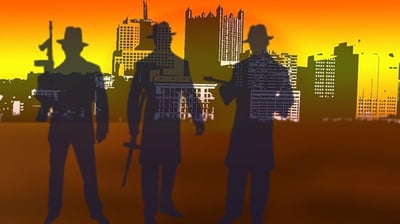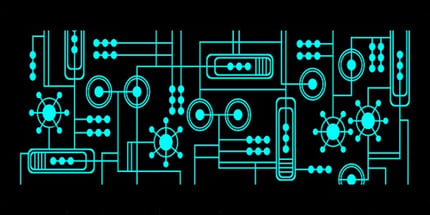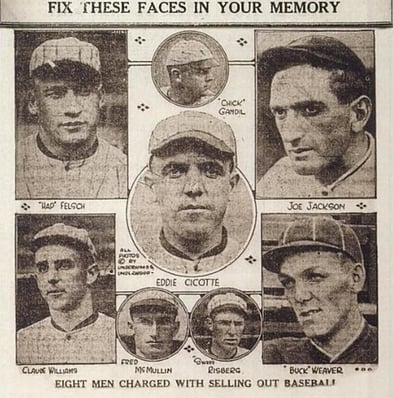
Fresh from the world of organized parties that we saw in Chapter 3, now we dive head-first into the world of organized crime. In The Great Gatsby Chapter 4, our narrator Nick gets a short private audience with one of New York's premier gangsters - Meyer Wolfshiem, Gatsby's business partner. But, just as Chapter 4 exposes the seamy side of get-rich-quick East Coast life, we also learn the origin story of Gatsby's love for Daisy.
So, basically: come to The Great Gatsby Chapter 4 for human teeth as jewelry, stay for the thwarted romance.
Quick Note on Our Citations
Our citation format in this guide is (chapter.paragraph). We're using this system since there are many editions of Gatsby, so using page numbers would only work for students with our copy of the book. To find a quotation we cite via chapter and paragraph in your book, you can either eyeball it (paragraph 1-50: beginning of chapter; 50-100: middle of chapter; 100-on: end of chapter), or use the search function if you're using an online or eReader version of the text.
The Great Gatsby: Chapter 4 Summary
Sunday morning, people come back to Gatsby's. New rumors circulate – that Gatsby is a bootlegger and that he is the nephew of German General von Hindenburg (a successful military commander in the war).
Nick makes a list of the people who came to Gatsby's parties that summer. There are East Egg names that sound very WASPy, West Egg names that are distinctly more ethnic-sounding (with clearly German, Polish, Irish, and Jewish names featured), and a bunch of theater names who connect back to the idea of Gatsby as a theater producer.
One morning in July, Gatsby picks Nick up in his beautiful car and takes him to Manhattan for lunch.
They don't have much to talk about, but suddenly, Gatsby tells Nick to ignore all the rumors about him – he'll tell him the real deal. According to Gatsby, he was born to a wealthy Midwestern family, his parents are dead, and he was educated at Oxford per family tradition.
Nick immediately thinks Gatsby is lying.
Gatsby continues his story: he bummed around Europe depressed until the war, then fought bravely enough to get medals from all the Allied governments. Gatsby shows Nick a real-looking medal inscribed to him and a photograph from his Oxford days. Nick is convinced. Apparently this crazy, too-good-to-be-true story really is true.
Gatsby tells Nick that this information is a kind of payment for a favor he will ask for later – mysteriously, Nick will find out what the favor is from Jordan.
On the drive to Manhattan, Nick sees Mr. Wilson in his gas station.
Gatsby is speeding, but when a policeman tries to pull him over, he shows the cop a white card and the cop politely and apologetically waves them on. Gatsby claims that this happened because the police commissioner owes him a solid.
Nick revels in the "anything goes" quality of Manhattan as they drive past a funeral procession and a car with both black and white passengers. Even Gatsby wouldn't stand out here.
At lunch, Gatsby introduces Nick to Meyer Wolfshiem, who is described in offensive anti-Semitic terms. Nick mocks his speech patterns, his appearance, and his mannerisms, which in his mind seem to connect as closely to Wolfshiem being Jewish as to him being a gangster.
Wolfshiem reminisces about another restaurant, where he witnessed a gangland execution (and was clearly an active participant in gang activity). Nick remembers the case, and that the shooters were put to death by electric chair. It suddenly turns out that Wolfsheim thinks that Gatsby introduced Nick as a potential business prospect, but Gatsby clarifies that Nick is simply a friend.
Gatsby apologizes for not telling Nick about whatever the favor will be, and then takes off to make a phone call, leaving Nick and Wolfshiem together. Wolfshiem talks Gatsby up to Nick, confirming that he is an Oxford man. Wolfsheim then points out that his own cufflinks are made out of human molars, and out of nowhere says that Gatsby would never hit on a friend's wife.
When Gatsby returns, Wolfshiem takes off. Nick wonders what he does for a living, and Gatsby tells him that Wolfshiem is a gambler – and the man who fixed the 1919 World Series (what's now also known as the "Chicago Black Sox Scandal"). Nick is staggered by the thought that one man could have done such a huge thing.
Nick then sees Tom in the restaurant, and they go over to say hello. Gatsby becomes extremely uncomfortable and disappears.
Later that day, Jordan tells Nick the following story:
In 1917, when she was 16, Jordan became good friends with Daisy in Louisville. Daisy was 18, super popular, with a white car, white clothes, and tons of boys asking her out.
On the day Daisy chose to single Jordan out as a new friend, Daisy was having a romantic afternoon with Jay Gatsby.
A few years later, Jordan heard a story that Daisy had tried to run away from home to say goodbye to a soldier going overseas.
Six months later, Daisy married Tom Buchanan in the biggest wedding ever. Tom's wedding present to Daisy was a pearl necklace worth $350,000 (over five million dollars in today's money).
Jordan was one of Daisy's bridesmaids. The night before the wedding, she found Daisy completely wasted, holding a letter. Daisy drunkenly cried and begged Jordan to call off the wedding. She then crumpled the letter up in the bathtub. But the next day, none of this was mentioned, and the wedding went fine.
After the honeymoon, Daisy seemed very much in love with Tom, but Tom was already cheating on her. Daisy, meanwhile, has never had affairs – at least none that anyone knows about.
Jordan finishes her story by saying that when Nick came to dinner with Daisy and Tom is the first time Daisy had heard the name Gatsby in all these years – and she realized that he was the same Gatsby she had known in Louisville.
Nick is amazed at the coincidence. Jordan replies that it's not a coincidence at all – Gatsby bought the house across the bay on purpose. Gatsby would like Nick to invite Daisy over one day, and then let Gatsby come over also, "accidentally" meeting Daisy there. Nick is floored by the insanity of this level of planning. Jordan thinks maybe Gatsby expected Daisy to come to one of his parties, and when that didn't happen, he made up this new plan. Nick and Jordan make out.
 I, for one, would love to see the flow chart of Gatsby's elaborately laborious planning process. Its wheels within wheels are at "Count of Monte Cristo" level!
I, for one, would love to see the flow chart of Gatsby's elaborately laborious planning process. Its wheels within wheels are at "Count of Monte Cristo" level!
Key Chapter 4 Quotes
"I'm going to make a big request of you today," he said, pocketing his souvenirs with satisfaction, "so I thought you ought to know something about me. I didn't want you to think I was just some nobody. You see, I usually find myself among strangers because I drift here and there trying to forget the sad thing that happened to me." (4.43)
The more Gatsby seems to reveal about himself, the more he deepens the mystery – it's amazing how clichéd and yet how intriguing the "sad thing" he mentions immediately is. It's also interesting that Gatsby uses his origin story as a transaction – he's not sharing his past with Nick to form a connection, but as advance payment for a favor. At the same time, there's a lot of humor in this scene. Imagine any time you told anyone something about yourself, you then had to whip out some physical object to prove it was true!
A dead man passed us in a hearse heaped with blooms, followed by two carriages with drawn blinds and by more cheerful carriages for friends. The friends looked out at us with the tragic eyes and short upper lips of south-eastern Europe, and I was glad that the sight of Gatsby's splendid car was included in their somber holiday. As we crossed Blackwell's Island a limousine passed us, driven by a white chauffeur, in which sat three modish Negroes, two bucks and a girl. I laughed aloud as the yolks of their eyeballs rolled toward us in haughty rivalry.
"Anything can happen now that we've slid over this bridge," I thought; "anything at all. . . ."
Even Gatsby could happen, without any particular wonder. (4.56-58)
In a novel so concerned with fitting in, with rising through social ranks, and with having the correct origins, it's always interesting to see where those who fall outside this ranking system are mentioned. Just he earlier described loving the anonymity of Manhattan, here Nick finds himself enjoying a similar melting-pot quality as he sees an indistinctly ethnic funeral procession ("south-eastern Europe" most likely means the people are Greek) and a car with both black and white people in it.
What is now racist terminology is here used pejoratively, but not necessarily with the same kind of blind hatred that Tom demonstrates. Instead, Nick can see that within the black community there are also social ranks and delineations – he distinguishes between the way the five black men in the car are dressed, and notes that they feel ready to challenge him and Gatsby in some car-related way. Do they want to race? To compare clothing? It's unclear, but it adds to the sense of possibility that the drive to Manhattan always represents in the book.
"Meyer Wolfshiem? No, he's a gambler." Gatsby hesitated, then added coolly: "He's the man who fixed the World's Series back in 1919."
"Fixed the World's Series?" I repeated.
The idea staggered me. I remembered of course that the World's Series had been fixed in 1919 but if I had thought of it at all I would have thought of it as a thing that merely happened, the end of some inevitable chain. It never occurred to me that one man could start to play with the faith of fifty million people--with the single-mindedness of a burglar blowing a safe.
"How did he happen to do that?" I asked after a minute.
"He just saw the opportunity."
"Why isn't he in jail?"
"They can't get him, old sport. He's a smart man."
(4.113-119)
Nick's amazement at the idea of one man being behind an enormous event like the fixed World Series is telling. For one thing, the powerful gangster as a prototype of pulling-himself-up-by-his-bootstraps, self-starting man, which the American Dream holds up as a paragon of achievement, mocks this individualist ideal. It also connects Gatsby to the world of crime, swindling, and the underhanded methods necessary to effect enormous change. In a smaller, less criminal way, watching Wolfshiem maneuver has clearly rubbed off on Gatsby and his convolutedly large-scale scheme to get Daisy's attention by buying an enormous mansion nearby.
Suddenly I wasn't thinking of Daisy and Gatsby any more but of this clean, hard, limited person who dealt in universal skepticism and who leaned back jauntily just within the circle of my arm. A phrase began to beat in my ears with a sort of heady excitement: "There are only the pursued, the pursuing, the busy and the tired." (4.164)
Nick thinks this about Jordan while they are kissing. Two things to ponder:
- Which one does he think he is: the pursued or the pursuing? The busy or the tired? Perhaps we are meant to match these adjectives up to the two people involved in the main love story, in which case Gatsby is both the pursuing and the busy, while Daisy is the pursued and the tired.
- If Tom, Daisy, and Gatsby are locked into a romantic triangle (or square, if we include Myrtle), then Jordan and Nick are vying for the position of narrator. Nick presents himself as the objective, nonjudgmental observer – the confidant of everyone he meets. So it's interesting that here we get his perspective on Jordan's narrative style – "universal skepticism" – right after she gets to take over telling the story for a huge chunk of the chapter. Which is the better approach, we are being asked, the overly credulous or the jaded and disbelieving? Are we more likely to believe Jordan when she says something positive about someone since she is so quick to find fault? For example, it seems important that she be the one to state that Daisy hasn't had any affairs, not Nick.
 Ladies and gentlemen, the 1919 Chicago "Black" Sox. Not major league baseball's finest hour.
Ladies and gentlemen, the 1919 Chicago "Black" Sox. Not major league baseball's finest hour.
The Great Gatsby Chapter 4 Analysis
How does the text of this chapter invoke the major themes of the novel? Let's investigate.
Overarching Themes
Society and Class. The list of East and West Egg names clearly ties into Tom's earlier fixation on the book about the "white race" being in danger of being overwhelmed by "other races". Here, we see that the people who until very recently were newcomer immigrants to America are now becoming rich enough to populate West Egg – and it is because of this seeming encroachment that the old money society is circling its wagons ever more. It is interesting that Gatsby's mansion is a kind of demilitarized zone where these two groups of people encounter each other.
The American Dream. Gatsby's attempt to sell Nick on an origin story of himself as the scion of a wealthy family again points to his desire for self-invention and self-mythologizing. It also shows that he doesn't want to present himself as an American Dream success story, but instead as an old money part of the upper crust.
Morality and Ethics. The introduction of Meyer Wolfshiem focuses our attention on the criminal enterprise pervading the Roaring 20s during the Prohibition. Meyer's active and powerful effect on the world around him – his ability to single-handedly fix the 1919 World Series – contrasts with the two other wealthy men we have met so far. Gatsby clearly at least somewhat admires Meyer's abilities and also pursues his desire with a big and bold play. Tom, meanwhile, is powerful only in a physically intimidating way, but has neither the vision nor the follow-through for any large accomplishments.
Love, Desire, and Relationships. The marriage of Tom and Daisy gets more complicated when we see that Daisy had had some kind of romantic connection with Gatsby beforehand, that she had extreme cold feet before going through with the wedding, and that Tom started having affairs as soon as their honeymoon ended. This gives context to some of Daisy's earlier despair and of course paints Tom in an even worse light.
Unreliable Narrator. Finally, we get a chance to see what a different kind of narrator would do with this story when Jordan takes over the storytelling duties for a while. She is judgmental, quick to mock her subjects, but the story she tells is psychologically cohesive and doesn't contradict what we now know of the characters. We are left wondering whether a narrator who puts all their biases up front is better than one who pretends to be totally objective like Nick.
 Tom's MO is to buy love - he pacifies Daisy's cold feet with pearls, and later finds Myrtle's moral qualms much cheaper to overcome.
Tom's MO is to buy love - he pacifies Daisy's cold feet with pearls, and later finds Myrtle's moral qualms much cheaper to overcome.
Crucial Character Beats
- Gatsby tells Nick an origin story: he's the son of wealthy now-dead Midwesterners, he went to Oxford, and then he fought bravely in WWI. Not only that, but he has a medal and a photograph to prove it!
- Gatsby introduces Nick to Meyer Wolfshiem. He is clearly affiliated with the Jewish mafia. (In fact, he is based on the real-life gangster Arnold Rothstein.) He is depicted with every horrible anti-Semitic stereotype available – everything from his appearance to the way he speaks is a racist caricature.
- Jordan fills Nick on Daisy and Tom's wedding. Daisy had had a romantic connection with Jay Gatsby before then, but ended up marrying Tom after a night of hysterically crying about wanting to call it off. A few months after the wedding, Tom was already cheating on her.
- Jordan also tells Nick that Gatsby bought the house across the bay from Tom and Daisy's on purpose. He wants Nick to invite Daisy over so that Gatsby can then "accidentally" stop by.
What's Next?
Get comfortable with the flashbacks and flashforwards of the narrative by checking out the chronological timeline of exactly what happens when in the story.
Compare Gatsby and Daisy's backstory with Fitzgerald's own youthful love affair to see how authors mine their own experiences to build a richer fictional world.
Move on to the summary of Chapter 5, or revisit the summary of Chapter 3.
Have friends who also need help with test prep? Share this article!

Anna scored in the 99th percentile on her SATs in high school, and went on to major in English at Princeton and to get her doctorate in English Literature at Columbia. She is passionate about improving student access to higher education.


































 Holly R.
Holly R.